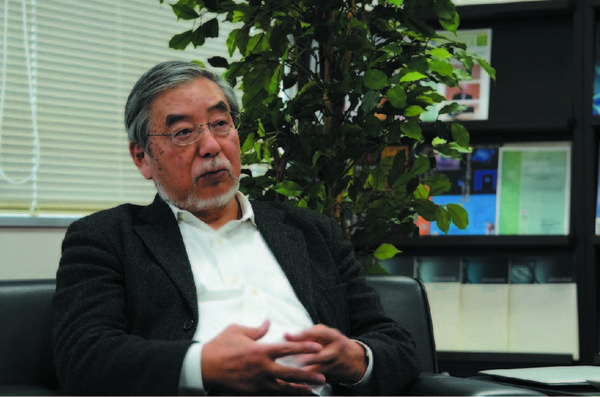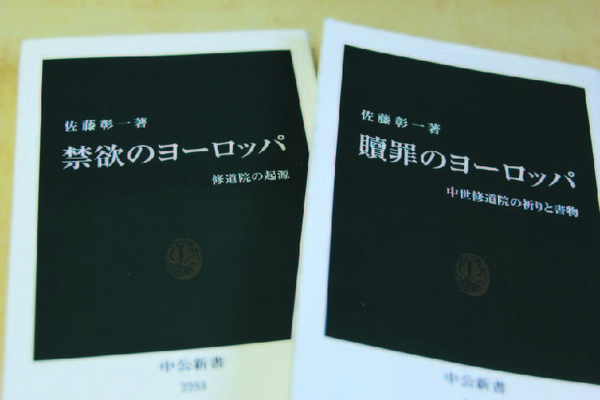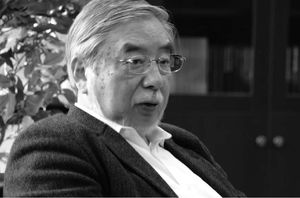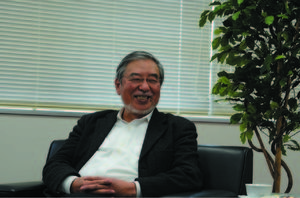Features
Features
The Academic Journey: from France to Japan
- ツイート
- 2018/05/09
Special Interview
Professor Emeritus Shoichi Sato
Source: IAR Letter, vol.16, March 2018
*about IAR: Nagoya University's Institute for Advanced Research was established to produce internationally recognized academic research of the highest caliber, and to contribute to society through the research achievements at the Institute.
 Dr. Shoichi Sato is a historian studying early medieval Europe renowned for his study of the Frankish history. He was born 1945 in Yamagata, Japan. He graduated from the Faculty of Law at Chuo University in 1976. He completed his Ph.D program without a Ph.D. degree from the Graduate School of Letters, Arts and Sciences at Waseda University in 1976 but received a Ph.D degree in Literature from the same university in 1995. He worked at the Faculty of Law and Economics at Aichi University as an assistant professor (1979-1987), at the School of Letters at Nagoya University as an associate- (1987-1991) and later as a full professor (1991-2009). He was the director of Nagoya-IAR from 2003 to 2004. Now he is a Professor Emeritus at Nagoya University and a member of the IAR Academy. During his career he was a visiting professor at many prominent French research institutions like the Centre national de la recherche scientifique (CNRS) (1995), the Collége de France (2001), the École Pratique des Hautes Études, the École des Hautes Études en Sciences Sociales (EHESS) Paris (2001) and the Université Paris I (2004). He has won numerous awards such as the Collège de France Lecture Medal (2001) and the Japan Academy Prize (2002).
Dr. Shoichi Sato is a historian studying early medieval Europe renowned for his study of the Frankish history. He was born 1945 in Yamagata, Japan. He graduated from the Faculty of Law at Chuo University in 1976. He completed his Ph.D program without a Ph.D. degree from the Graduate School of Letters, Arts and Sciences at Waseda University in 1976 but received a Ph.D degree in Literature from the same university in 1995. He worked at the Faculty of Law and Economics at Aichi University as an assistant professor (1979-1987), at the School of Letters at Nagoya University as an associate- (1987-1991) and later as a full professor (1991-2009). He was the director of Nagoya-IAR from 2003 to 2004. Now he is a Professor Emeritus at Nagoya University and a member of the IAR Academy. During his career he was a visiting professor at many prominent French research institutions like the Centre national de la recherche scientifique (CNRS) (1995), the Collége de France (2001), the École Pratique des Hautes Études, the École des Hautes Études en Sciences Sociales (EHESS) Paris (2001) and the Université Paris I (2004). He has won numerous awards such as the Collège de France Lecture Medal (2001) and the Japan Academy Prize (2002).
~Throughout my middle and high school years baseball was my all-consuming passion. In high school I did little else but baseball.~
-- Your area of specialty is European medieval history, especially Francia. What led to this choice?
SATO: I studied law as an undergraduate student. When I applied for university I didn't have any clear plan.
Throughout my middle and high school years baseball was my all-consuming passion. In high school I did little else but baseball. I was a member of the Sakata Higashi High School baseball team (in Yamagata Prefecture), where I was a pitcher and cleanup hitter. When I was in my third year our team narrowly missed playing at the Summer Koshien, the National High School Baseball Championship, after reaching the prefectural semifinals. After that, in around late August, I started thinking about which university I should apply for, when I heard that a law degree was pretty "marketable," and so, without much thought, I chose the department of law, thinking I could always decide about my future later on. I only had three or four months to prepare for my entrance exams, so I chose a private university, because there were fewer subjects on the exam than at public ones. I applied for the department of law at Chuo University, which at the time boasted the highest success rate for the bar exam, and somehow managed to be admitted to the university on my first attempt.
However, after about a month or two, I realized that I had made the wrong choice. To me the general education subjects were simply the most fascinating. These were at the time taught by part-time instructors from the University of Tokyo, who were first-class. Perhaps as a reaction to doing hardly anything else but baseball until then, I suddenly found myself greatly stimulated intellectually. I decided to study humanities subjects properly at graduate school. I enrolled in a postgraduate course at Waseda University, where I studied Western history.
Undergraduate law studies didn’t disappear completely from my head, though. The disciplines of history and law have always been closely related. The shift from antiquity to the Middle Ages (Roman times to Frankish) also involved a legal shift from Roman law to Germanic tribal law. As a reader of history, I was highly interested in the state of law at such transitional times.
~My father, who ran a long-established kimono retailing business, didn’t object when I asked him to pay for my studies abroad. I said I will give up my share of inheritance instead.~
-- In 1969, while a postgraduate student at Waseda University, you went to study at the University of Caen in France.
SATO: It was a time when student movements were all the rage, with the fall of the Yasuda Auditorium and other incidents, which made situations at universities very chaotic. I was in the first year of my master’s course, but classes weren’t always held smoothly in those circumstances. So I considered studying abroad as an alternative. My father, who ran a long-established kimono retailing business, didn’t object when I asked him to pay for my studies abroad. I said I will give up my share of inheritance instead.
I studied for about two years in France, which was a very good thing for me. I learned in France what I needed to learn properly before being affected by conventions of Japanese learned society. Europe is, after all, the center of studies in European history. It was highly beneficial that it was in Europe that I learned from a clear slate what to make of history as a discipline, what training the discipline involved, and how to conduct viable research. There were of course drawbacks once it came to building a career in Japan, such as needing to be equipped with a certain framework, or common understanding, shared by the members of Japanese learned society. Although not without dilemma, my academic beginnings were basically removed from Japanese learned society.
Studying abroad had non-academic merits as well. Normandy, where the University of Caen is, is very verdant, and remains one of my favorite places. Students over there would completely switch off on weekends. They cloistered themselves in the library from Monday to Friday, went to the movies on Saturday as if to get away from it all, went to the disco straight after the movie, spent the whole night having fun, and took the car out to the sea at dawn, where they might have bonfires. Student life was hectic, but great fun.
--France was where you met your future wife.
SATO: Yes, I met her when she was a fellow study-abroad student on a language course. We married and our first child was born after we returned to Japan, and when I was doing my doctoral course back at Waseda University Graduate School. My student life involved both babysitting and essay writing.
In 1979, when I was 32 or so, I was fortunate enough to get a job at a relatively young age. I became an associate professor of Western legal history at the faculty of law and economics at Aichi University (Toyohashi City). From 1984 I spent two years in Paris as an Aichi University overseas researcher.
My wife and two daughters accompanied me to Paris, where my daughters attended a local elementary school, although they didn’t even know their ABCs when they started.
-- During your time as an overseas researcher you visited many monasteries.
SATO: Whenever there were long holidays I took my family in an old, secondhand Audi to various parts of France, as well as Italy and Spain. We visited a lot of monasteries too, despite the grumblings of my wife and daughters. Early monasteries, from the 6th and 7th centuries, were often made of wood, which made surviving examples extremely rare. Many monasteries also lay in ruins after being abolished. Nothing remained of about half the monasteries we visited, which were just empty plots, to the great disappointment of my daughters. There were always plaques, though, or information boards for us to read, telling how the place was once the site of a certain monastery, and so on.
~In Japanese scholarly circles, bipartite manor system had largely been viewed as a kind of slavery. However, I was not convinced by this view.~
-- You compiled your research on early medieval society into Shudoin to Nomin [Monasteries and Peasants] published by Nagoya University Press in 1997.
SATO: In or around the 9th century, many monasteries started keeping written accounts of the administration of their manors and tenants, and surviving examples of these records serve as invaluable historical sources today. The kind of manors described in these materials existed under a system known as bipartite manorialism. In Japanese scholarly circles, bipartite manor system had largely been viewed as a kind of slavery. However, I was not convinced by this view.
My attention was drawn to a series of accounting documents thought to have been made at the Abbey of St. Martin of Tours during the 7th century, or late Merovingian dynasty. The material is fragmented and very difficult to read, which was why it had largely escaped scholarly attention until then. I researched the material’s provenance, and went on to decipher and analyze it largely with the advices from Pierre Gasnault and Jean Vezin who had published a transcription of the texts in 1975, for the first time. I consequently found that the material was a series of notes made by the local monastery when collecting tributes from its tenants. Some describe cases where tenants refused to settle outstanding amounts of tribute. Refusing payment is not an attitude commonly associated with slaves. This suggests that bipartite manor system was not a slavery-like system, and that tenants, though dependent on monasteries to an extent, maintained their personal freedom. This reaffirmed my belief that the idea of early medieval European society as rooted in slavery needed reviewing. I compiled this research into Shudoin to Nomin.
-- In 2014 you published Kinyoku no Yoroppa [Asceticism in Europe], and in 2016 Shokuzai no Yoroppa [Atonement in Europe], both by Chuko Shinsho.

SATO: These were intended for a general readership, rather than as academic treatises. In Japan, studies of monasteries tend to be written or translated by Christian scholars. I am a Buddhist, not at all Christian. That could be a sort of hurdle, but I believe there are also viewpoints uniquely available to a person to whom the subject of investigation is not an object of worship.I wanted to base my historical overview of monastic systems on asceticism because the notion of asceticism is ever-present at the root of European monastic systems.
In December 2017 I published a sequel to the earlier books, Ken to Seihin no Yoroppa [The Sword and Honorable Poverty in Europe]. The book discusses military orders and mendicant orders from around the 12th to 15th centuries. Together the three books summarize my account of monastic orders from ancient to medieval times.
Also in the pipeline, though I haven’t written it yet, is a work dealing with the Society of Jesus. The Jesuits were different from monastic orders that were born in the Middle Ages. And importantly, the Jesuits affected Japan. The history of Christianity’s spread during Japan’s Sengoku and early Edo periods (from the end of the 16th to 17th centuries) is studied today by young scholars in Europe, leading to fresh findings. They analyze historical sources archived in Portugal and other locations associated with the Jesuits, which had hardly been seen in Japan before, and I am greatly looking forward to discovering what they reveal.
And to finish off my series, I intend to write a fifth book dealing with the 17th century and beyond. In the 17th century, after monasticism in its original sense had lost the clout it enjoyed in the Middle Ages, monastic orders survived as academic institutions. The foundation of history as a discipline was built by members of such monastic orders. I want to complete my series with this topic, which I find interesting also from the point of history’s evolution as a discipline.
 ~Cutting-edge research trends in the West makes me want to destroy conventional frameworks in one way or another. I want to be bold in my approach.~
~Cutting-edge research trends in the West makes me want to destroy conventional frameworks in one way or another. I want to be bold in my approach.~
-- You also conduct active research into the history of the Franks.
SATO: The history of the era of the Franks is where my scholarly roots are. The history of the Franks is slightly tricky. The noun “Frank” is originally an adjective meaning “bold” or “courageous.” It is not associated with a place name like “Goths from Gothland” or “Nagoyaites from Nagoya.” Franks are, in a sense, secondary groups resulting from the integration of various small and medium-size tribes. Identifying their ancestry is not easy given the lack of records. Their roots date back to the pre-era, late Bronze Age or early Iron Age, the study of which involves the use of prehistoric archaeological, rather than historical, materials.
The ancestors of the Franks could be found in the north, in the North Sea and Baltic Sea areas, making their living primarily from selling amber to the Romans. Before gemstones like diamonds and opals, amber was a jewel in its own right. Excavations of ancient Egyptian and ancient Syrian tombs often yield amber, which when analyzed, invariably show that they were brought from the Baltic Sea area. This supports the idea of a “world-system” in history, which is increasingly believed to have existed from about 3,000 years ago.
Recent advancements made by archaeology are truly impressive. For example, excavations have managed to track down to a certain degree of accuracy that trade existed between the Baltic Sea and Black Sea areas as early as 2000 BCE. I think going back that far in time, informed by archaeological findings, is absolutely necessary in order to reveal the origins of the Frank people. I would like to give the title “In Search of the Land of Origins” to the first part of my work.
-- Going as far back as pre-Greek prehistoric times is a novel approach for the study of Frankish history, isn't it?
SATO: Absolutely. I don’t think anyone has done it yet, which is why it is innovative, and at the same time, susceptible to attracting suspicion. Ancient Greek folklore and knowledge include many aspects that suggest links with peoples of the north. I want to take my investigations that far.
Cutting-edge research trends in the West makes me want to destroy conventional frameworks in one way or another. I want to be bold in my approach.
~ …someone who lived in the far past becomes a part of myself; it becomes possible for me to identify with that person, though we live in different eras. I think approaching history with this sense of identification with others enables us to better understand humanity.~
-- How would you justify the fascination, or meaningfulness, of learning about history, including that of the Franks?
SATO: Just imagine how tragic it would be for a person to have no memory. Translate this situation to a group of people—a community. Whether a single country or the entire world, humans desire to know what actually happened, in other words, “history.” Living is otherwise not possible. And I think the discipline of history is about investigating what really happened, or what is most likely to have happened.
The era of the Franks has absolutely nothing to do with the Japanese; it is totally unrelated. However, by researching the subject, a picture emerges of how people lived in a certain region at a certain time. The people mentioned in the above accounting records kept at the Abbey of St. Martin of Tours were clearly peasants, who left no other trace in history. But when I, as a historian, read their names, understand the kinds of taxes they owed annually, and the kinds of activities they engaged in, someone who lived in the far past becomes a part of myself; it becomes possible for me to identify with that person, though we live in different eras. I think approaching history with this sense of identification with others enables us to better understand humanity.
-- The recent tendency in Japan is to scale down undergraduate bunkei (social sciences and humanities) programs at universities, including history programs. There are arguments for making bunkei subjects available only at top universities, and turning the rest into vocational institutions serving the needs of industry, because unlike rikei (science) subjects, bunkei subjects of study do not directly contribute to the country’s economic development. What is your view on this?
SATO: This is clearly a wrong idea. Although the term “bunkei” encompasses diverse disciplines, at the core of all bunkei subjects is the desire to understand humanity.
In today’s society, people who have completed undergraduate bunkei courses of study could be working, for instance as company employees, or perhaps they are raising children at home. The experiences of studying disciplines for understanding human beings must surely have significant effects on the ordinary, day-to-day lives of these people. The idea of doing away with such experiences is to deny the development of a more mature society.
I cannot understand why we need to gauge, at this point, the [economic] efficiency of the output of bunkei disciplines, which is to understand humans. I feel that it is a shortsighted idea held by a handful of industry players.
-- You have spent many years in France. How do you feel about the education system in France?
SATO: My two daughters attended local schools in France, so education was a very pertinent issue. From my experience as a parent, French education spares no effort in cultivating the ability to think.
High school students take the baccalauréat exams before graduation, which are pretty grueling. For a philosophy exam, for example, because philosophy is among the subjects taught in high school, students sit exams lasting up to three or four hours writing a ten-A4-page essay on a fairly subjective topic, for instance pertaining to Kant. And although the exam is taken by hundreds of thousands of students, markers rank each and every essay as 1st, 2nd and so on. I don’t think such subjective exams would be feasible unless the markers were fairly confident in their own ability to build intellectual arguments, judge and analyze, yet the French baccalauréat exam somehow manages to do it. I think French education cultivates that kind of intellectual tenacity. The same can be said about individual scholars, whom I feel are outstanding in their tenacity of thought.
-- In Europe, Britain is now in negotiations to leave the EU. What do you think lies in store for Europe?
SATO: France is arguably the country fearing any EU dissolution the most. The idea of the EU itself historically originates in France’s longtime wish to have Germany under control, so as not to repeat the tragedy of the two world wars. French international policy over the recent two hundred years has been based on how to avoid confrontation with Germany, and maintain a good relationship. For this reason, France wants to avoid any EU dissolution at all costs. After Brexit, French President Emmanuel Macron will probably try to carry on maintaining the EU as best as he can through coordinated efforts with German Chancellor Angela Merkel.
 --In 2016 you gave a lecture in the presence of the Japanese Emperor and Empress.
--In 2016 you gave a lecture in the presence of the Japanese Emperor and Empress.
SATO: Yes, a very memorable event. On January 12, 2016 I had the honor of giving a lecture titled “The Cultural Significance of Western Medieval Monasticism” in the presence of the Emperor, Empress and other members of the imperial family in the Matsu-no-ma grand hall at the Imperial Palace.
In the lecture I discussed the copying of texts by medieval monks. Without this activity, ancient Greek and Roman texts would not have survived to this day. Today, about 2,000 ancient text survive, including fragments and later copies which have been written down before the year 800. This is only a fraction considering that aristocratic residences of ancient Rome invariably had libraries housing huge collections of books. The small number survives because of the medieval monastic scribes. Without the copies they made, Aristotle and Socrates would be unknown to us. In view of this, we could risk depriving future generations of records of the present age if we converted everything published today into electronic media. These were some of the topics covered by the lecture.
The experience was immensely rewarding for me personally because I greatly admired the range of activities conducted by the Emperor and Empress after World War II. After seeing a photograph of me lecturing, a friend in Paris sent the compliment, “Like Alcuin lecturing to Charlemagne,” which was very flattering.
Interview with Prof. Sato was done by Nagoya IAR faculties and C. Tsuboi (Chunichi Shimbun Co., Ltd). This interview article was written by C. Tsuboi and translated to English under the responsibility of Nagoya IAR.
Related Links
Download letter_vol.16_SpecialInterview.pdf
NU Research
(English)

